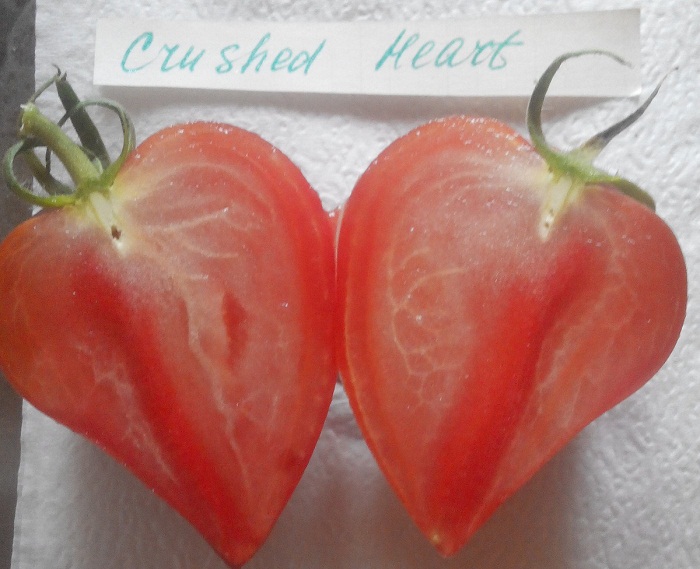 Tomato variety Crushed heart belongs to the category of mid-ripening plants and is suitable for growing in greenhouse conditions. An exception may be southern regions with a predominantly warm climate and early termination of spring frosts.
Tomato variety Crushed heart belongs to the category of mid-ripening plants and is suitable for growing in greenhouse conditions. An exception may be southern regions with a predominantly warm climate and early termination of spring frosts.
The bushes are indeterminate and in height can reach about 1.5 - 1.8 m.
Content
Grade characteristics
The main feature of the variety is the elegant heart-shaped shape of the fruits with a sharp tip. The leaves are thin with a normal shape and dark green color. Bushes need to pinch the side shoots, so that the main ones are 1-2 stems. On each of the brushes, 5 to 6 fruits are formed. Tomatoes themselves at the time of ripening acquire a pink-purple color with characteristic touches of golden color. The taste of the fruit is balanced and sweet enough, the flesh is fleshy, and their average weight is about 200 - 400 g.
The high productivity of the grown bushes is due to the ability to get about 5 - 6 kg of tomatoes per 1 sq.m. In this case, the density of planting seedlings is limited to only 3 plants. You can use ripe tomatoes fresh, as well as for the preparation of juices and sauces. They are also recommended to be used subject to dietary restrictions.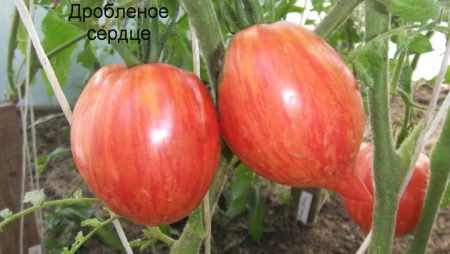
Recommendations for growing seedlings
Sowing tomato seeds Crushed heart in the prepared fertilized soil must be carried out 60 - 65 days before the planned planting at a constant place of growth. It is necessary to place the seeds to a depth of not more than 1 cm. At the same time, the distance between them should be no less than 1.5 - 2 cm. During sowing, the soil should be moist, but without stagnation of water, since in this situation the seeds will not be able to receive oxygen. The second important point concerns sufficient soil friability, which can be achieved by adding coarse river sand to the soil.
As for soil fertilizers in seedling containers, it is not recommended to use fresh manure or unripened compost. From mineral complexes should choose options with the presence of potassium, copper, nitrogen and calcium. During the germination and strengthening of the stems, no top dressing is allowed, since they can cause a burn of the too sensitive root system of future tomatoes.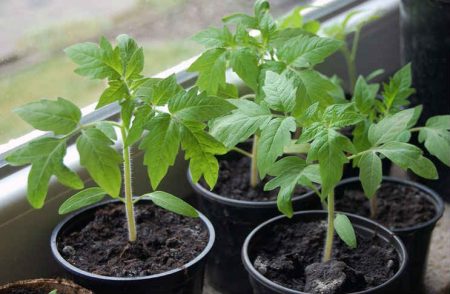
Watering is carried out regularly, but extremely moderately with the obligatory use of warm, settled water with a temperature not lower than 28 - 30 degrees. As for the room itself, it should be bright and warm (about 23 - 27 degrees heat). All containers with future seedlings are covered from above with transparent glass or film. This trick will allow condensate to accumulate on the surface, preventing it from evaporating outward, thereby saving the soil from drought.
Since the soil with seeds needs daily ventilation, the protective film must be removed for several hours. As soon as the first sprouts begin to appear (5-8 days after sowing), the shelter is removed completely. At the time of transplantation of stronger seedlings, its age should be at least 35 - 40 days. In this case, the stems themselves should have 3 to 4 full leaflets.
Growing rules
Planting seedlings on open ground is possible only under conditions of a warm climate and long summers. The bushes grow quite high, so they require careful tying to an additional support or trellis method. The variety is quite thermophilic, therefore it requires the absence of sudden changes in temperature and may suffer from the return of night frosts.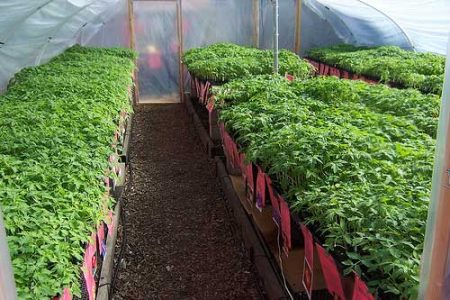
Fertilizing the soil is carried out at least 3 to 4 times per season and includes:
- autumn soil fertilization with rotted compost, manure, bird droppings or any other organic substrate with mandatory digging of the site;
- the introduction of mineral complexes into the soil during the planting process of grown seedlings;
- before the expected appearance of the first flowers on the bushes.
Timely mulching will help protect the soil from drying out - covering the basal ground with material that does not allow sunlight and does not allow moisture to evaporate from the ground. Of the mandatory care requirements, it is also worth highlighting weed harvesting and loosening of the soil to fully saturate it with oxygen. 10 to 12 days after planting, the bushes neatly swell. The distance between the bushes should be no less than 40 - 50 cm. The maximum yield of seedlings can be achieved precisely with greenhouse cultivation.
Pests and diseases
Among the main dangers of growing tomatoes Crushed heart is the defeat of Fusarium, which is manifested by rotting of the root system and neck, as well as late blight and apical aphid, accompanied by the appearance of brown spots and the rapid destruction of not only the leaves and stems, but also the fruits themselves.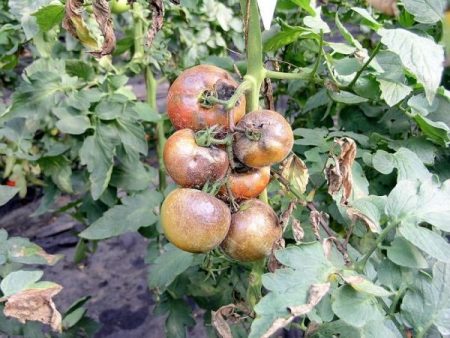
For the prevention of dangerous diseases, you can use a soda solution (250 g per 8 - 9 liters of water) or a two-day garlic infusion (250 - 300 g squeezed garlic in 7 - 8 liters of water). The spraying procedure can be carried out no earlier than 12-15 days after planting tomato bushes in a permanent place. After another week, all work must be repeated again. As an alternative, it is recommended to use a two-day infusion of celandine, for which you need 10 liters of water and at least 1 - 1.5 kg of chopped fresh grass.
In the fight against harmful insects fungicides are often used. In this case, personal protective equipment must be used, and the work itself is carried out no later than 2 weeks before the first harvest. If plants are grown in a greenhouse, one of the dangerous pests is a spider mite. For the purpose of prevention, it is necessary to carry out full and regular ventilation of the room, as well as observing the optimal level of air humidity (about 50 - 60%). From the recipes, it is worth paying attention to the three-day ash infusion, which requires sifted wood ash and clean water in a ratio of 1 to 10.
Reviews
Fedor Ivanovich, 68 years old
Variety of tomatoes Crushed heart is quite difficult to pick a root system during a transplant from a container into a permanent soil. This work must be carried out very carefully or stockpiled in small separate containers in advance and grow all the seeds separately. The second important point concerns the complete exclusion of cold drafts in places where tomatoes sprout, from which the plants stop in development and die.
Ekaterina Vasilievna, 48 years old
From fusarium and late blight, onion and garlic husks, laid in a hole to the roots of tomato bushes, can help. Growing seedlings should be carried out in a warm, bright place, but without direct sunlight. When tying up, more attention should be paid to brushes with ripening fruits and the ability to apply a trellis method to support bushes. Watering the planted bushes, as well as the tomato seedlings themselves, should be carried out exclusively with warm water.




 Low-growing tomatoes, without pinching: 5 of the most delicious varieties
Low-growing tomatoes, without pinching: 5 of the most delicious varieties Why tomato seedlings grow poorly
Why tomato seedlings grow poorly We grow a tomato in a shell
We grow a tomato in a shell Growing tomatoes without watering according to the method of Kazarin
Growing tomatoes without watering according to the method of Kazarin